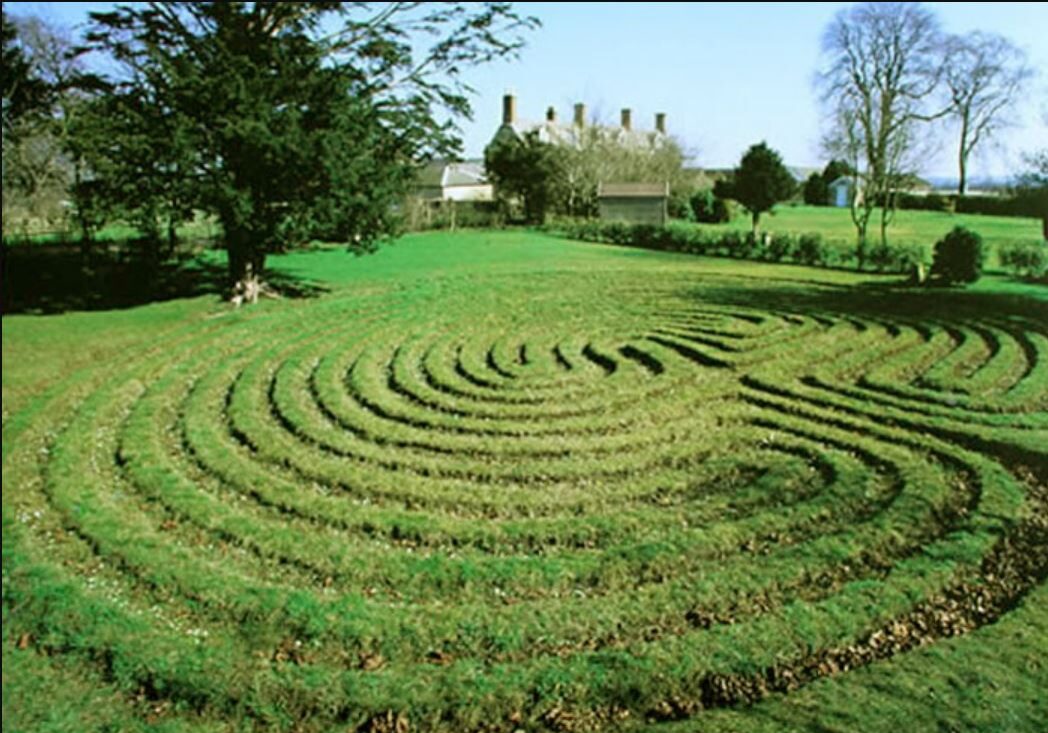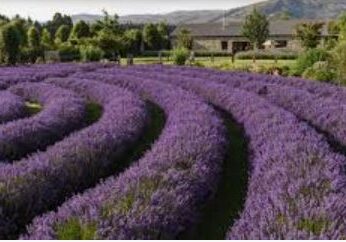
The Lavender labyrinth
Lavender, (genus Lavandula), genus of about 30 species of plants in the mint family (Lamiaceae), native to countries bordering the Mediterranean. Lavender species are common in herb gardens for their fragrant leaves and attractive flowers.
The plants are widely cultivated for their essential oils, which are used to scent a variety of products. The dried flowers, for example, have long been used in sachets to scent chests and closets, and the ancient Romans used lavender in their baths.
Lavender is sometimes also used to flavor beverages and sweets and has a number of applications in herbal medicine. English lavender (Lavandula angustifolia), French lavender (L. stoechas), and woolly lavender (L. lanata) are among the most widely cultivated species.

Ancient designs
Historic "Troy" turf mazes in England
A seven-ring Classical labyrinth. The "Troy" mazes at Dalby and Somerton are based on this ancient design.
Medieval labyrinth
Of the eight surviving historic turf mazes in England, three have "Troy" names. "The City of Troy" is a small but well-maintained roadside maze near the small villages of Dalby, Brandsby, and Skewsby, not far from Sheriff Hutton in the Howardian Hills of North Yorkshire. "Troy", a beautiful maze in a private garden at Troy Farm, Somerton, Oxfordshire, is rather larger, and "Troy Town" maze on St Agnes, Isles of Scilly, is a small maze of turf and small stones and is reputed to have been laid down in 1729 by the son of a local lighthouse keeper.
All three follow the classical labyrinth pattern (as found on coins from ancient Knossos) rather than the medieval variation. It is not known when the first two of these turf mazes were originally constructed; however, the turf was re-cut at Dalby in 1900 due to road damage.
PARALLELS IN SCANDINAVIA,
the Baltic and White Sea coasts
There are also similar labyrinths in northern continental Europe. Their paths are outlined with stones (unlike the turf-cut mazes of England, and those that formerly existed in Denmark). Stone-lined labyrinths such as these have proved slightly easier to date than turf mazes (which have to be cleaned out regularly to keep their paths clear, thus destroying any archaeological evidence). The stone labyrinths around the Baltic coast have been dated to between the 13th century and modern times, with a peak in the 16th and 17th centuries.
There were once many hundreds, perhaps even thousands, of these labyrinths around the Baltic Sea, throughout Fennoscandia and the Baltic countries, and many of them still survive, particularly in remote areas. There are also similar stone labyrinths in the Kola Peninsula and coasts and islands of the White Sea, such as Stone labyrinths of Bolshoi Zayatsky Island. For some reason these northern labyrinths are almost all close to the sea. Some have suggested that they were markings of seafarers, perhaps even used for navigation. Many of the stone labyrinths around the Baltic coast of Sweden were built by fishermen during rough weather and were believed to entrap evil spirits, the "smågubbar" or "little people" who brought bad luck. The fishermen would walk to the centre of the labyrinth, enticing the spirits to follow them, and then run out and put to sea.


Several similar classical-type labyrinths in Scandinavia have names such as Trojaborg, Trojaburg, Trojborg, Tröborg and Trojienborg, which can all be translated as "City of Troy". (The place-name Trelleborg, which means "ring fort", has also been linked with labyrinths.) In Finland such labyrinths are called Jatulintarha ("giant's garden" or "giant's corral") or jättiläisen tie ("giant's road"). In Finland they have also been called by the names of notable biblical places, such as Jerusalem, and walking through the maze was regarded as a symbolic pilgrimage to the place it was named after. In Finland's Swedish speaking coastal areas the labyrinths are called jungfrudans or "maiden's dance".

More about
English lavender (Lavandula angustifolia) in Norfolk, England.
Lavenders are small evergreen shrubs with gray-green hoary linear leaves. The purple flowers are sparsely arranged on spikes at the tips of long bare stalks and produce small nutlet fruits. The fragrance of the plant is caused by shining oil glands imbedded among tiny star-shaped trichomes (plant hairs) that cover the flowers, leaves, and stems. The plants in cultivation do not usually produce seed, and propagation is accomplished by cuttings or by dividing the roots.
lavender oil
Lavender oil, or lavender flower oil, is obtained by distillation of the flowers and is used chiefly in fine perfumes and cosmetics. It is a colourless or yellow liquid, the fragrant constituents of which are linalyl acetate, linalool, pinene, limonene, geraniol, and cineole. Lavender water, a solution of the essential oil in alcohol with other added scents, is used in a variety of toilette preparations.










